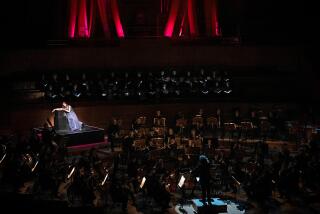A Tuneful, Timely ‘Lollapalooza’
- Share via
John Adams’ “Lollapalooza” lasted just under seven minutes when Marin Alsop conducted it to open her Hollywood Bowl program with the Los Angeles Philharmonic Tuesday night. It was a very easy seven minutes. The piece is a small dazzler. It has a deliberate, boogaloo bass line. Winds and strings dance above in all-American syncopated counterpoint. It is happy-go-lucky music, and it couldn’t be more American. I noticed smiles all around me.
There is nothing peculiar about this kind of music as a concert opener. Some of the best overtures--like those to Rossini operas or the concert overtures of Gershwin--are similar. Still, this was an occasion for the Bowl. It is the only piece of music from our time (it was written two years ago for Simon Rattle’s 40th birthday) and from our part of the planet played by the Los Angeles Philharmonic thus far this summer.
The Philharmonic, which is among the most admirable of orchestras in its programming during the winter, seems to become dazed by the bright incessant Southland sun in the summer. Unlike, say, the Boston Symphony at Tanglewood or the Chicago Symphony at Ravinia, our orchestra asks the players, week after week, to forget who they are and why they live where they live. They play only the same, aging, foreign classics over and over. Audiences are condescended to, as if they might rebel the way Mozart’s aristocracy did if asked to turn attention away from the banquet for a moment.
It wasn’t always so, as the Bowl loves to boast when it reminds us of its history. The Hollywood Bowl Museum is a delightful display of photos of composers who once came here, of yellowed program books bursting with adventurous repertory, of wonderful videos, including a prominent one of John Cage saying how musically rich his experiences at the Bowl were way back when. Tuesday proved, in a very small way, that it needn’t be otherwise in our more cynical times.
Indeed, the greatest value of “Lollapalooza” was simply that it was new and lively. It immediately focused the orchestra’s attention, and that of the audience, as well, an attentiveness that lasted through the warhorses to come.
Mendelssohn’s Violin Concerto was entrusted to one of this season’s parade of young soloists, Tamaki Kawakubo. Though only 17, she’s not an unknown here. She performed at the Bowl four years ago (although at her age, four years means the world). She was a student locally, at the Colburn School before being trotted off to Juilliard to be put in the inevitable hands of star-maker Dorothy Delay.
But apparently she was better prepared for Delay than most. Kawakubo’s playing does not have that bland, perfect sheen, that sense that every small detail has been drilled into the fingers to the point of mechanical precision that marks Delay clones. She is an agile, virtuosic player with--if the sound system can be trusted for accurate pronouncements--a centered, piercing tone. She doesn’t let an obsession for intonation get in the way of the moment. She doesn’t even seem to have, yet, an idealized conception of the piece.
*
And so she played as if she were actually enjoying herself. Not everything was secure. She plays too fast, and she plays too slow. She milks the lyricism, but the sentiment doesn’t stick for a second, and she is ready to dash off into the showy stuff, completely having forgotten what she was just feeling. In other words, she is a genuine 17-year-old. She deserves watching.
And then there was the ultimate Bowl cliche--Gustav Holst’s suite “The Planets,” performed under the stars. This time it was splendid. Alsop is a savvy conductor. She knew exactly what could and could not be accomplished in a single rehearsal. There may not have been all the mystery that Holst wrote into the score, but the Hollywood Bowl is not exactly Roswell, N.M.
Instead, Alsop focused on rhythm and propulsion. She conducted like an American, giving Holst’s catchy syncopations a slight swing that was downright irresistible. Alsop, who is music director of the Colorado Symphony, has come a long way since Leonard Bernstein first attempted to make a star of her at Tanglewood a decade ago. It is now time for our planet, at least, to start paying serious attention.
More to Read
The biggest entertainment stories
Get our big stories about Hollywood, film, television, music, arts, culture and more right in your inbox as soon as they publish.
You may occasionally receive promotional content from the Los Angeles Times.











